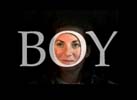Nino Rodgriguez
Boy
1994
USA
Biography
 Nino
Rodriguez is thirty, and he's lived in Los Angeles forever. He never practiced
piano enough, and always played the music no one likes to hear. Music theory
still nags him even after earning an MFA in Film and Video at UCLA. Since
1988, his short videos, films, and digital media have shown at the Dallas
Video Festival, the International Film Festival Rotterdam, the Museum of
Modern Art, and other places, too. Nino's won prizes in seven countries,
and people said intellectual things about his work at The Robert Flaherty
Seminar. Nino is currently working on long-term plans, sees his friends
sporadically, and spends his nights wondering if he leads an artificial life.
Nino
Rodriguez is thirty, and he's lived in Los Angeles forever. He never practiced
piano enough, and always played the music no one likes to hear. Music theory
still nags him even after earning an MFA in Film and Video at UCLA. Since
1988, his short videos, films, and digital media have shown at the Dallas
Video Festival, the International Film Festival Rotterdam, the Museum of
Modern Art, and other places, too. Nino's won prizes in seven countries,
and people said intellectual things about his work at The Robert Flaherty
Seminar. Nino is currently working on long-term plans, sees his friends
sporadically, and spends his nights wondering if he leads an artificial life.
Conceptual Description
 A young woman searches for her early childhood. The fragments collide and
tenuously connect. She struggles to reconstruct her history. A hesitation,
and she starts again. Emotional truth provides little solid ground. A narrative
erupts and immediately dissolves. Her desire for meaning imperfectly masks
uncertainty. She re-examines her memory and assembles a new past.
A young woman searches for her early childhood. The fragments collide and
tenuously connect. She struggles to reconstruct her history. A hesitation,
and she starts again. Emotional truth provides little solid ground. A narrative
erupts and immediately dissolves. Her desire for meaning imperfectly masks
uncertainty. She re-examines her memory and assembles a new past.
A participant watches the young woman speak. Her words fill the space behind
her image. There is no more room. Her words disappear and begin again. The
participant intervenes. The woman's image is gone, but her voice persists.
The participant interrupts. The young woman is here again. She repeats herself,
but what follows is new. Another intervention. Another repetition. Another
path.
The young woman's stories are divided into over one hundred short moments.
The order she tells them is determined randomly. Our desire to pull meaning
from the whole interferes with an awareness that the pieces follow each other
arbitrarily. The encounter both portrays and reproduces the uncertainty of
memory. Her desire to find truth infects the participant's desire to comprehend.
Where traditional media transform memory into nostalgia, we are discovering
what interactive media will manufacture from our desire.
Boy can be exhibited as a one-on-one experience, displayed continuously
as an installation, or screened for an audience. (Running time: 10+ minutes,
1994)
 Nino
Rodriguez is thirty, and he's lived in Los Angeles forever. He never practiced
piano enough, and always played the music no one likes to hear. Music theory
still nags him even after earning an MFA in Film and Video at UCLA. Since
1988, his short videos, films, and digital media have shown at the Dallas
Video Festival, the International Film Festival Rotterdam, the Museum of
Modern Art, and other places, too. Nino's won prizes in seven countries,
and people said intellectual things about his work at The Robert Flaherty
Seminar. Nino is currently working on long-term plans, sees his friends
sporadically, and spends his nights wondering if he leads an artificial life.
Nino
Rodriguez is thirty, and he's lived in Los Angeles forever. He never practiced
piano enough, and always played the music no one likes to hear. Music theory
still nags him even after earning an MFA in Film and Video at UCLA. Since
1988, his short videos, films, and digital media have shown at the Dallas
Video Festival, the International Film Festival Rotterdam, the Museum of
Modern Art, and other places, too. Nino's won prizes in seven countries,
and people said intellectual things about his work at The Robert Flaherty
Seminar. Nino is currently working on long-term plans, sees his friends
sporadically, and spends his nights wondering if he leads an artificial life.
 A young woman searches for her early childhood. The fragments collide and
tenuously connect. She struggles to reconstruct her history. A hesitation,
and she starts again. Emotional truth provides little solid ground. A narrative
erupts and immediately dissolves. Her desire for meaning imperfectly masks
uncertainty. She re-examines her memory and assembles a new past.
A young woman searches for her early childhood. The fragments collide and
tenuously connect. She struggles to reconstruct her history. A hesitation,
and she starts again. Emotional truth provides little solid ground. A narrative
erupts and immediately dissolves. Her desire for meaning imperfectly masks
uncertainty. She re-examines her memory and assembles a new past.